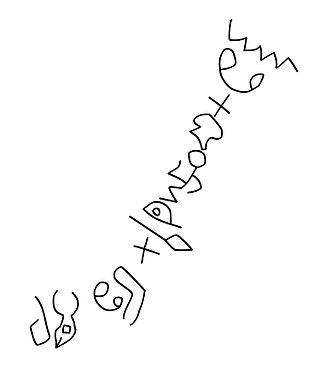
An alphabet is a standard set of letters written to represent particular sounds in a spoken language. Specifically, letters largely correspond to phonemes as the smallest sound segments that can distinguish one word from another in a given language. Not all writing systems represent language in this way: a syllabary assigns symbols to spoken syllables, while logographies assign symbols to words, morphemes, or other semantic units.

N, or n, is the fourteenth letter of the Latin alphabet, used in the modern English alphabet, the alphabets of other western European languages, and others worldwide. Its name in English is en, plural ens.

Writing is the act of creating a persistent representation of human language. A writing system uses a set of symbols and rules to encode aspects of spoken language, such as its lexicon and syntax. However, written language may take on characteristics distinct from those of any spoken language.

Ancient Egyptian hieroglyphs were the formal writing system used in Ancient Egypt for writing the Egyptian language. Hieroglyphs combined ideographic, logographic, syllabic and alphabetic elements, with more than 1,000 distinct characters. Cursive hieroglyphs were used for religious literature on papyrus and wood. The later hieratic and demotic Egyptian scripts were derived from hieroglyphic writing, as was the Proto-Sinaitic script that later evolved into the Phoenician alphabet. Egyptian hieroglyphs are the ultimate ancestor of the Phoenician alphabet, the first widely adopted phonetic writing system. Moreover, owing in large part to the Greek and Aramaic scripts that descended from Phoenician, the majority of the world's living writing systems are descendants of Egyptian hieroglyphs—most prominently the Latin and Cyrillic scripts through Greek, and the Arabic and Brahmic scripts through Aramaic.
The Phoenician alphabet is an abjad used across the Mediterranean civilization of Phoenicia for most of the 1st millennium BC. It was one of the first alphabets, and attested in Canaanite and Aramaic inscriptions found across the Mediterranean region. In the history of writing systems, the Phoenician script also marked the first to have a fixed writing direction—while previous systems were multi-directional, Phoenician was written horizontally, from right to left. It developed directly from the Proto-Sinaitic script used during the Late Bronze Age, which was derived in turn from Egyptian hieroglyphs.

The Ugaritic writing system is a cuneiform abjad with syllabic elements used from around either 1400 BCE or 1300 BCE for Ugaritic, an extinct Northwest Semitic language. It was discovered in Ugarit, modern Ras Shamra, Syria, in 1928. It has 30 letters. Other languages, particularly Hurrian, were occasionally written in the Ugaritic script in the area around Ugarit, although not elsewhere.

Serabit el-Khadim is a locality in the southwest Sinai Peninsula, Egypt, where turquoise was mined extensively in antiquity, mainly by the ancient Egyptians. Archaeological excavation, initially by Sir Flinders Petrie, revealed ancient mining camps and a long-lived Temple of Hathor, the Egyptian goddess who was favoured as a protector in desert regions and known locally as the mistress of the turquoise. The temple was first established during the Middle Kingdom in the reign of Sesostris I and was partly reconstructed in the New Kingdom.
The Canaanite languages, sometimes referred to as Canaanite dialects, are one of four subgroups of the Northwest Semitic languages. The others are Aramaic and the now-extinct Ugaritic and Amorite language. These closely related languages originated in the Levant and Upper Mesopotamia. Ancient Semitic-speaking peoples spoke them in an area encompassing what is today Israel, Palestine, Jordan, the Sinai Peninsula, Lebanon, Syria, as well as some areas of southwestern Turkey, Iraq, and the northwestern corner of Saudi Arabia. From the 9th century BCE, they also spread to the Iberian Peninsula and North Africa in the form of Phoenician.
Proto-Canaanite is the name given to:
- The Proto-Sinaitic script when found in Canaan, dating to about the 17th century BC and later.
- A hypothetical ancestor of the Phoenician script before some cut-off date, typically 1050 BC, with an undefined affinity to Proto-Sinaitic. No extant "Phoenician" inscription is older than 1000 BC. The Phoenician, Hebrew, and other Canaanite dialects were largely indistinguishable before that time.
The Paleo-Hebrew script, also Palaeo-Hebrew, Proto-Hebrew or Old Hebrew, is the writing system found in Canaanite and Aramaic inscriptions, including pre-Biblical and Biblical Hebrew, from southern Canaan, also known as the biblical kingdoms of Israel (Samaria) and Judah. It is considered to be the script used to record the original texts of the Bible due to its similarity to the Samaritan script; the Talmud states that the Samaritans still used this script. The Talmud described it as the "Livonaʾa script", translated by some as "Lebanon script". However, it has also been suggested that the name is a corrupted form of "Neapolitan", i.e. of Nablus. Use of the term "Paleo-Hebrew alphabet" is due to a 1954 suggestion by Solomon Birnbaum, who argued that "[t]o apply the term Phoenician [from Northern Canaan, today's Lebanon] to the script of the Hebrews [from Southern Canaan, today's Israel-Palestine] is hardly suitable". The Paleo-Hebrew and Phoenician alphabets are two slight regional variants of the same script.
Zayin is the seventh letter of the Semitic abjads, including Phoenician zayn 𐤆, Hebrew zayīnז, Aramaic zain 𐡆, Syriac zayn ܙ, and Arabic zāyز. It represents the sound.
He is the fifth letter of the Semitic abjads, including Phoenician hē 𐤄, Hebrew hēה, Aramaic hē 𐡄, Syriac hē ܗ, and Arabic hāʾه. Its sound value is the voiceless glottal fricative.
The history of the alphabet goes back to the consonantal writing system used to write Semitic languages in the Levant during the 2nd millennium BC. Nearly all alphabetic scripts used throughout the world today ultimately go back to this Semitic script. Its origins can be traced to the Proto-Sinaitic script that represented the language of Semitic-speaking workers and slaves in Egypt. Unskilled in the complex hieroglyphic system used to write the Egyptian language, which required a large number of pictograms, they selected a small number of those commonly seen in their surroundings to describe the sounds, as opposed to the semantic values, of their own Canaanite language. This script was partly influenced by the older Egyptian hieratic, a cursive script related to Egyptian hieroglyphs. The Semitic alphabet became the ancestor of multiple writing systems across the Middle East, Europe, northern Africa, and South Asia, mainly through Phoenician and the closely related Paleo-Hebrew alphabet, and later Aramaic and the Nabatean—derived from the Aramaic alphabet and developed into the Arabic alphabet—five closely related members of the Semitic family of scripts that were in use during the early 1st millennium BC.
Northwest Semitic is a division of the Semitic languages comprising the indigenous languages of the Levant. It emerged from Proto-Semitic in the Early Bronze Age. It is first attested in proper names identified as Amorite in the Middle Bronze Age. The oldest coherent texts are in Ugaritic, dating to the Late Bronze Age, which by the time of the Bronze Age collapse are joined by Old Aramaic, and by the Iron Age by Sutean and the Canaanite languages.

The Byblos script, also known as the Byblos syllabary, Pseudo-hieroglyphic script, Proto-Byblian, Proto-Byblic, or Byblic, is an undeciphered writing system, known from ten inscriptions found in Byblos, a coastal city in Lebanon. The inscriptions are engraved on bronze plates and spatulas, and carved in stone. They were excavated by Maurice Dunand, from 1928 to 1932, and published in 1945 in his monograph Byblia Grammata. The inscriptions are conventionally dated to the second millennium BC, probably between the 18th and 15th centuries BC.

The Latin script is the most widely used alphabetic writing system in the world. It is the standard script of the English language and is often referred to simply as "the alphabet" in English. It is a true alphabet which originated in the 7th century BC in Italy and has changed continually over the last 2,500 years. It has roots in the Semitic alphabet and its offshoot alphabets, the Phoenician, Greek, and Etruscan. The phonetic values of some letters changed, some letters were lost and gained, and several writing styles ("hands") developed. Two such styles, the minuscule and majuscule hands, were combined into one script with alternate forms for the lower and upper case letters. Modern uppercase letters differ only slightly from their classical counterparts, and there are few regional variants.

The Wadi el-Hol inscriptions are two rock inscriptions which appear to show some of the oldest examples of phonetic alphabetic writing discovered to date.
F. W. "Chip" Dobbs-Allsopp is a biblical scholar, epigrapher, and literary theorist. Currently professor of Old Testament, or Hebrew Bible, at Princeton Theological Seminary, he has taught and written extensively on Semitic languages, the origins of alphabetic writing, biblical poetry, poetics, and literary criticism.

Ancient Semitic-speaking peoples or Proto-Semitic people were speakers of Semitic languages who lived throughout the ancient Near East and North Africa, including the Levant, Mesopotamia, the Arabian Peninsula and Carthage from the 3rd millennium BC until the end of antiquity, with some, such as Arabs, Arameans, Assyrians, Jews, Mandaeans, and Samaritans having a continuum into the present day.

The Serabit el-Khadim proto-Sinaitic inscriptions are about 30 early alphabetic inscriptions in proto-Sinaitic script found at or in the vicinity of Serabit el-Khadim on the Sinai Peninsula.












